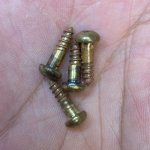Vtshopdog said:
I generally use yellow zinc construction screws to hang drywall......
[big grin]
Why? When there are perfectly good Tap-Cons.... [big grin]
I am generally against drywall screws for the Phillips head reason, they suck.
I have had a few break upon "attempted" extraction, but they are also likely to strip the head out.
Occasionally, I will get a repair job at the shop, usually loaded with drywall screws [mad]
They go straight in the bin.
In Norm's defense, same as Michael said above, there weren't many alternatives.
I too have been rewatching some of the old episodes, since there is now an official channel on Youtube, instead of pirated home video copies.
I am much more familiar in my memories of the later episodes. It odd to watch the early ones where the shop seems almost barren? In the first several episodes of season 1, there is no out-feed support or side support between the rails. That saw looks so lonely out in the middle of that space. The back hutch is not there either. I remember him building that in one show.
It was never "fine furniture", but I really didn't remember how crude some of it was, at least in the beginning? There again, it was decades ago.


